Decryptinator (currently v1.0) - A strategic typing game
(Scroll down for how to play)
Decryptinator is a strategic typing game, where you manage a system to help you tackle tasks efficiently.
The game was inspired by PC creators, and was first attempted to be coded using pure html, css and js in 2021.
The game is later created as a self learning project for practicing React.js since April 2024.
The first version of the game is released on July 2024.
The game is dedicated to Meliora, specifically Daniel, who encouraged me to give React.js a try.
You will need to play this game on a device with a keyboard.
Decryptinator is a strategic typing game, where you manage a system to help you tackle tasks efficiently.
The game was inspired by PC creators, and was first attempted to be coded using pure html, css and js in 2021.
The game is later created as a self learning project for practicing React.js since April 2024.
The first version of the game is released on July 2024.
The game is dedicated to Meliora, specifically Daniel, who encouraged me to give React.js a try.
You will need to play this game on a device with a keyboard.
Gameplay screenshots:
Layout of the in-game laboratory:
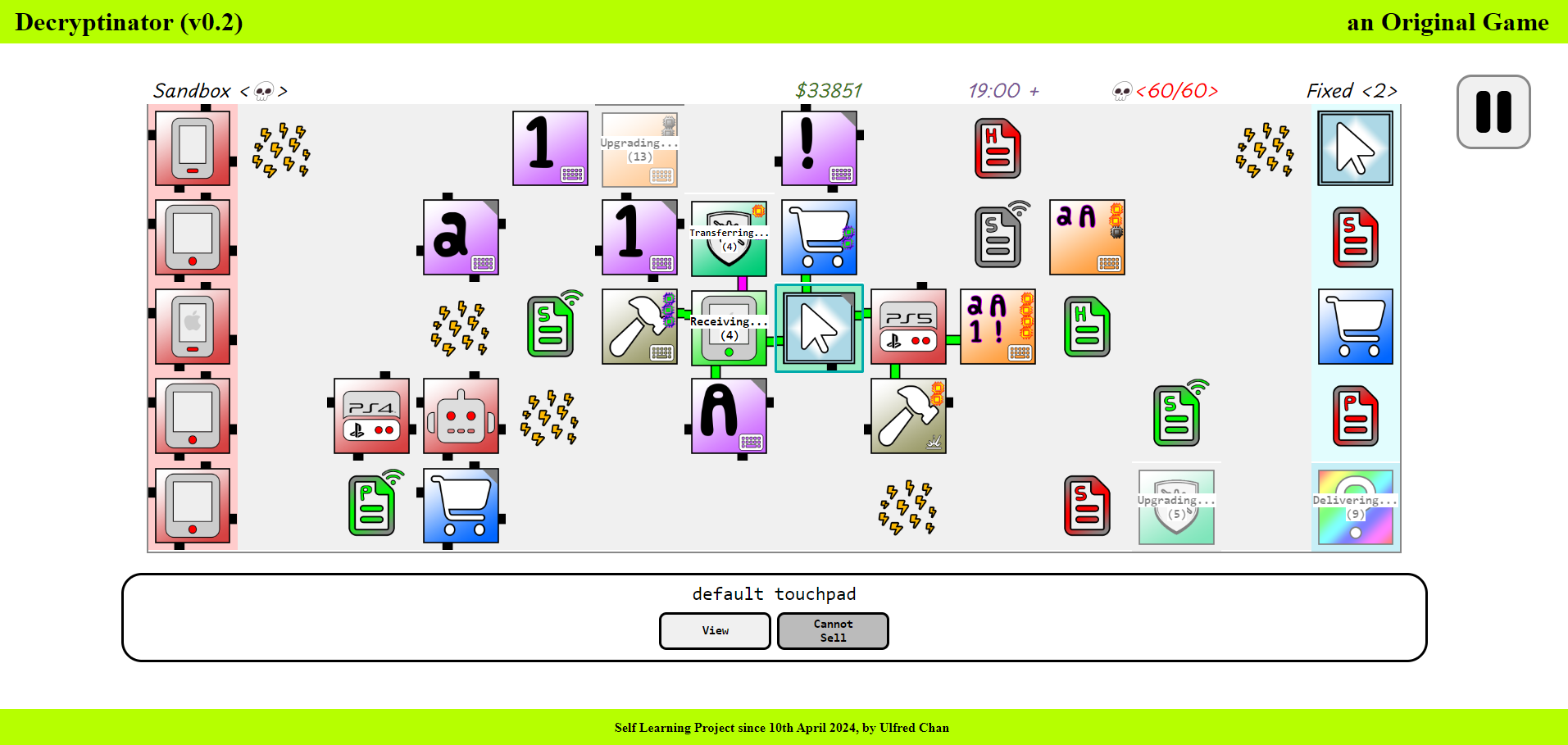
Visualization of blocks from a touchpad:
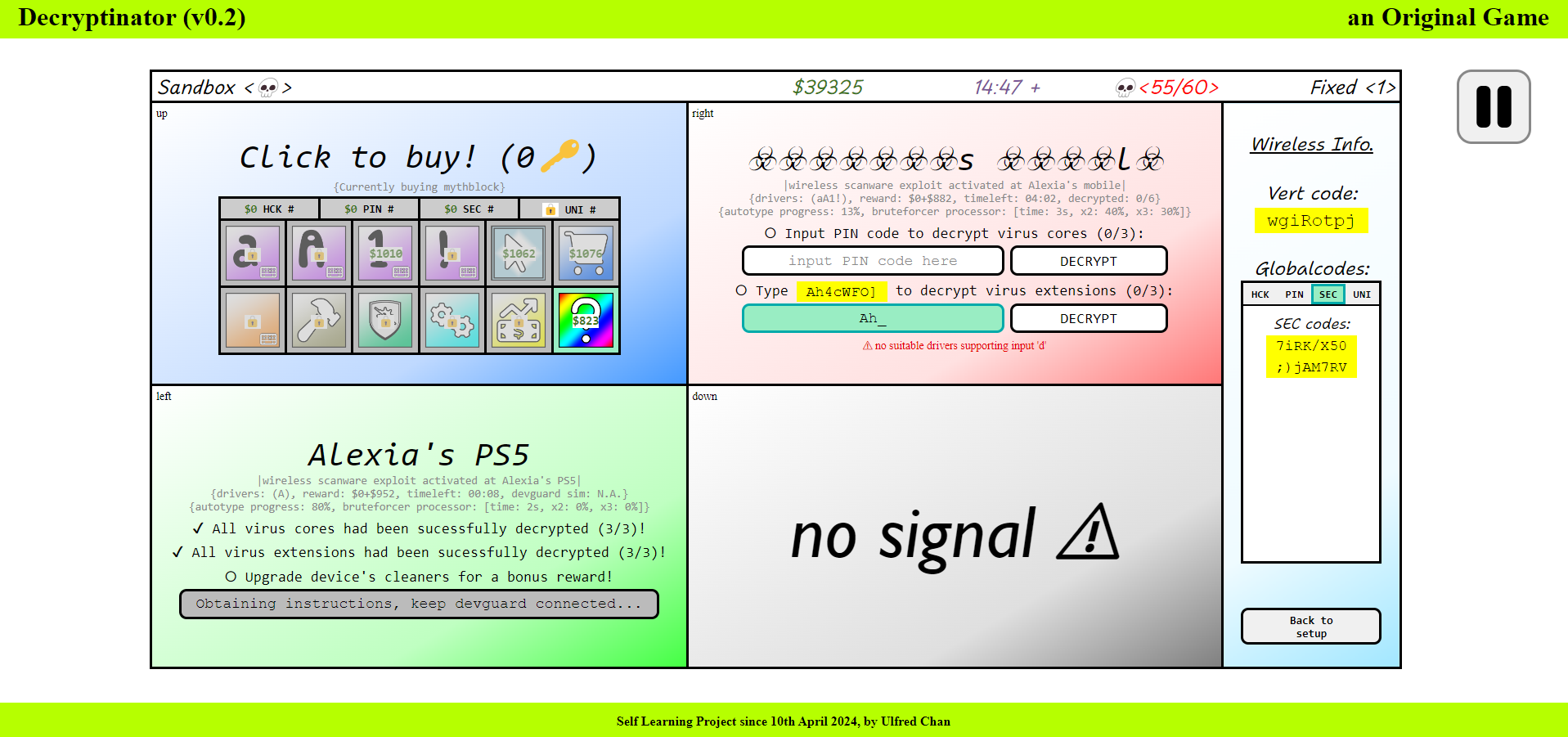
How to play: (in progress)
Background:
It's 2050 and the world's strongest hacker-squad, Cyberbust, has developed a deadly cryptovirus that encrypts all sorts of electronics! Once a device is encrypted, it cannot be properly accessed and used! As the world comes into chaos with devices being restricted one by one, You, a professional software engineer, has successfully developed special techblocks in your lab that together form a decrypting system that you named the "Decryptinator" which could decrypt the viruses and make devices function normally again! After your success, many users reached out to you for help. While you started making a profit out of it, your technology was also unfortunately leaked to Cyberbust and consensus was made to "cyberhack" your lab until your lab comes to a halt? Under this ongoing crisis, how many devices could you successful fix and how much profit could you earn?
Gamemodes and Objectives:
There are different gamemodes to this game, but all gamemodes share a common objective of decrypting viruses in hacked devices.
For gamemodes 20 min, 40 min, 60 min - Your objective is to fix the most devices within the respective time limit.
For gamemodes 30 fixes, 60 fixes, 100 fixes - Your objective is to be the fastest to fix the respective number of devices.
For gamemodes 3 Stars, 5 Stars, your business is doing rapidly well, but it loses a star when you fail to fix a customer's device in time. Your objective is to the fix the most devices before you lose all your stars.
Gamemodes 3 RStars, 5 RStars is the same as 3 Stars and 5 Stars, but stars will regenerate if you successfully fix 5 devices in a row after you lose a star.
For the gamemode Rental, you are a businessman who rented the lab and tried to make a profit out of it. However, you will need to pay for the rent time after time. Your objective is to the fix the most devices before you can't pay your rent.
For the gamemode Sandbox, you play endlessly in a Sandbox demo.
For gamemodes 20 min, 40 min, 60 min - Your objective is to fix the most devices within the respective time limit.
For gamemodes 30 fixes, 60 fixes, 100 fixes - Your objective is to be the fastest to fix the respective number of devices.
For gamemodes 3 Stars, 5 Stars, your business is doing rapidly well, but it loses a star when you fail to fix a customer's device in time. Your objective is to the fix the most devices before you lose all your stars.
Gamemodes 3 RStars, 5 RStars is the same as 3 Stars and 5 Stars, but stars will regenerate if you successfully fix 5 devices in a row after you lose a star.
For the gamemode Rental, you are a businessman who rented the lab and tried to make a profit out of it. However, you will need to pay for the rent time after time. Your objective is to the fix the most devices before you can't pay your rent.
For the gamemode Sandbox, you play endlessly in a Sandbox demo.
Layout and Controls:
When you start the game, you will view have an overview of your whole laboratory:

Above the laboratory displays some game information, including the gamemode, starting difficulty/modifiers, current cash in hand, in-game time, current game difficulty and the device fixcount. Within the laboratory can be divided into 3 parts, the loading zone, the workzone, and the delivery zone. Devices will spawn in the loading zone and deliveries will be sent to the delivery zone. Blocks cannot be moved into the loading zone and the delivery zone, but can only be moved out from these zones to the workzone. Below the laboratory is a description box, which is used to access block components. Blocks cannot be accessed in the loading zone and the delivery zone, but can only be accessed in the workzone. At the beginning of the game, some default blocks are provided as shown above. Default blocks are labelled with a gray triangle on the top right and cannot be sold.
To move blocks, click on the block you want to move, and click on an empty space in the workzone. Do not drag the block. When clicked, the block will have a green backdrop and a green outline, indicating that it is being selected. Selected blocks can be accessed using the buttons in the description box when accessable. Click on the block again to deselect the block. Click on another block to select another block.
To move blocks, click on the block you want to move, and click on an empty space in the workzone. Do not drag the block. When clicked, the block will have a green backdrop and a green outline, indicating that it is being selected. Selected blocks can be accessed using the buttons in the description box when accessable. Click on the block again to deselect the block. Click on another block to select another block.
Decrypting cryptovirus:
The main game objective involves in decrypting cryptoviruses within hacked devices in red, and returning the fixed device to customers within the time allowed by the customer. The simplest way to do so is to connect a device to a touchpad and suitable drivers in the workzone. Then, access the touchpad by clicking on the touchpad and the "View" button in the description box.
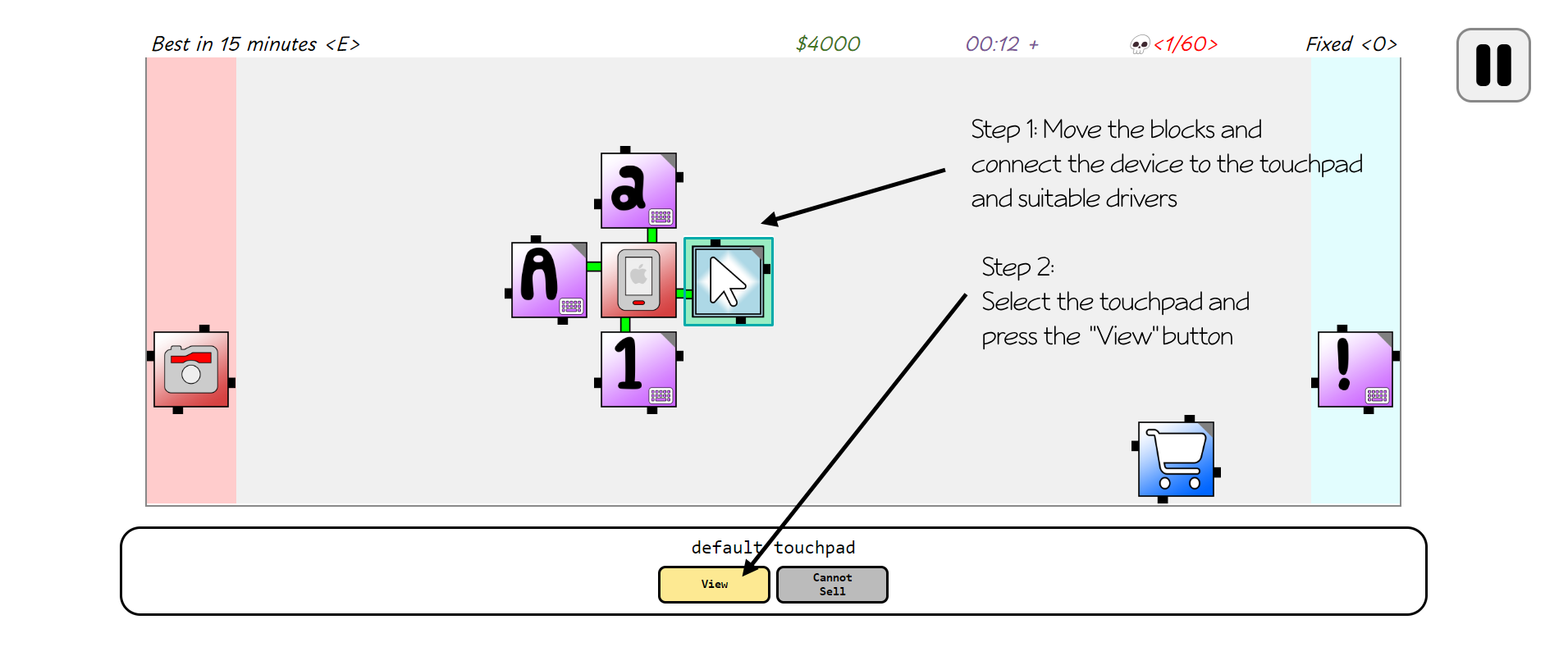
After pressing "View", you should be able to view the device with the touchpad. Afterwards, follow the instructions and type the code highlighted in yellow in the corresponding input box. In order to type certain characters, you would need to have the corresponding drivers connected to the device. You may need to return to the laboratory setup to readjust the device's attached drivers, which you can do so by pressing the bottom-right button. After the code is inputted, press the decrypt button and the device will slowly decrypt the virus. Once all viruses are decrypted, the device's background will turn green and you can return the device for corresponding profit.
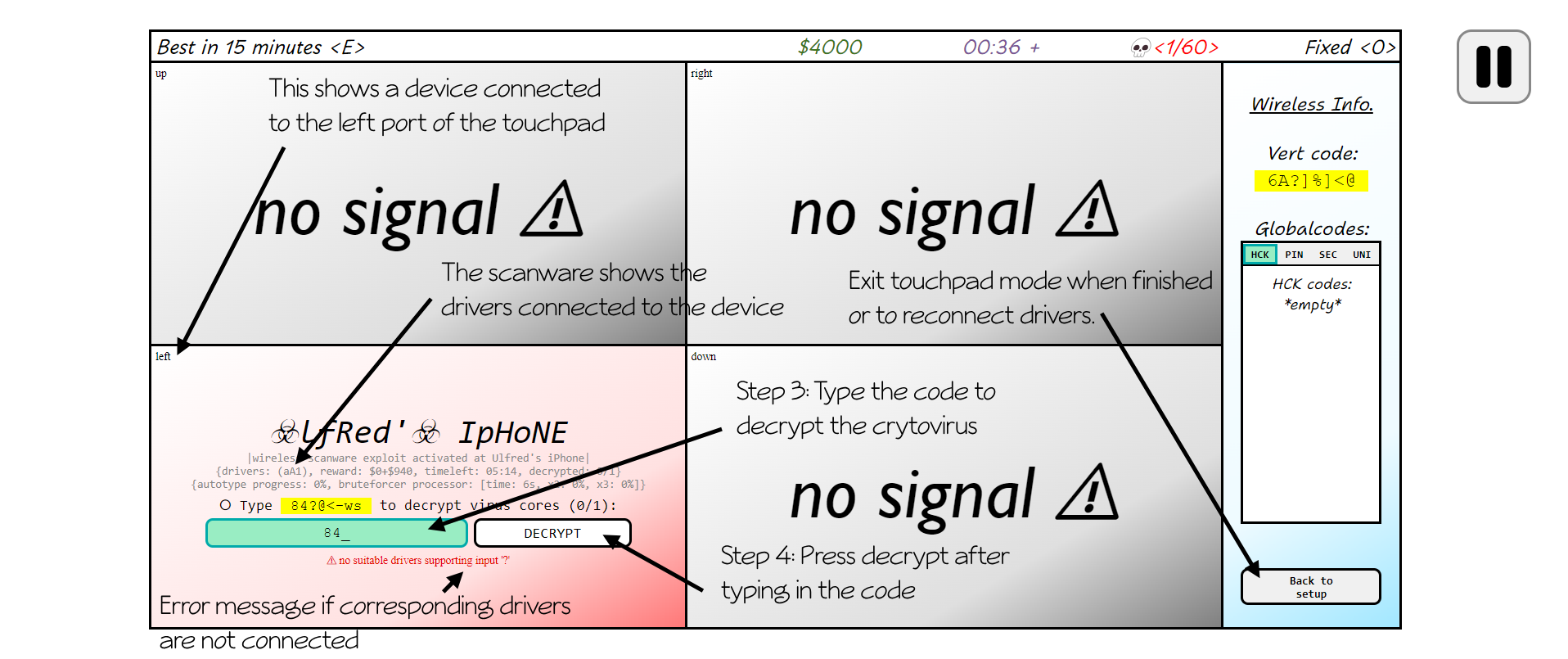
Game progression:
As the game progresses, the difficulty will slowly increase until it reaches the maximum difficultly of 60, increasing by 1 around every minute or when 2 devices are being fixed. There shall initially be 2 devices. Devices will spawn around 5 minutes with the 1st device spawning around 2.5 minutes into the game, or when 5 devices are fixed. The harder the difficulty, the more complex it is to decrypt cryptoviruses within devices. More powerleaks will also spawn within the laboratory. However, with the cash earned, you could purchase blocks that provide further support to the decrypting process by using the shopware with a connected touchpad.
Blocks:
There are 2 types of blocks. Interactable blocks and support blocks. Interactable blocks include devices, shopware, labcontrol and coinminer while support blocks include drivers, touchpad, multidrivers, bruteforcers and devguards. Interactables blocks can only be connected to support blocks but not other interactable blocks and support blocks can only be connected to interactable blocks but not only support blocks. After purchasing a block, you may purchase UCon, DCon, LCon and RCon without any upgrade time to allow it to connect to blocks above, below, to the left and to the right of it respectively. You may also further upgrade the block or sell it at around half of all costs spent on the block. Further upgrades takes time and upgrades are indicated by different colored computer chips on the top right of the block. Below is a list of all the blocks and a detailed description of them.
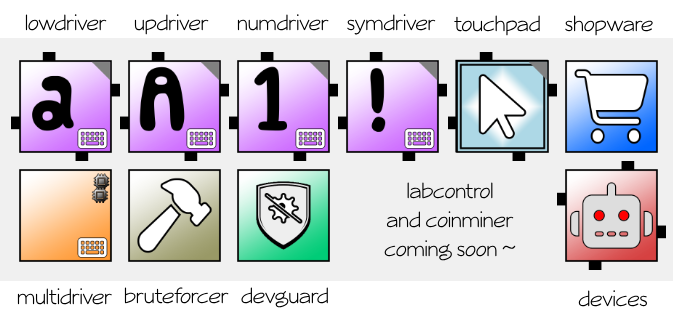
Drivers:
Drivers are purple support blocks. There are 4 drivers in this game: the lowdriver, updriver, numdriver and symdriver, which allows adjacent blocks to input lowercase letters, uppercase letters, numbers and symbols respectively. They can also be merged into a multidriver, which allows adjacent blocks to input multiple types of characters all at once. Default drivers however, cannot be merged.
Touchpad:
Touchpads are sky-blue support blocks that allow users to visualize and interact with the data within connected interactable blocks.
Shopware:
Shopwares are dark blue interactable blocks that are used to further purchase blocks. At first, you may only purchase HCK, PIN, SEC codes and more shopwares and you will need to unlock other items to purchase them. Purchased blocks will then be sent to the delivery zone and can be moved and used when the delivery is complete. You may upgrade the shopware's "service" to lower item prices and delivery time and upgrade the shopware's "stock" to get more keys. You may also purchase a mythblock from the shopware, which becomes a random block every time.
Multidriver:
Multidrivers are orange support blocks that allow adjacent blocks to input multiple types of characters all at once. Once bought and moved to the workzone, you may select a non-default driver block and merge to the multidriver. The multidriver will then allow adjacent blocks to input characters supported by the merged driver. You may upgrade the "capacity" of the multidriver to allow more drivers to merge into it.
Bruteforcer:
Bruteforcers are gold support blocks that increases the processing efficiency of connected blocks. The verification, decryption, and installation time of adjacent blocks will thus be lowered, and the time can be further reduced with further upgrades. You may then choose one of two routes to upgrade. Choosing the "powerbreak" upgrade will increase the probability for a decryption to decrypt multiple viruses at once and installations to skip additional steps. Further upgrades will further increase the probability of these events. Choosing the "autotype" upgrade will allow auto-insertion of code and auto decryption and installation when the code is filled in. Further upgrades will increase the speed of these auto-actions.
Devguard:
The devguard is a green support block that allows installation of safety software to adjacent devices. When connected to a fixed device, the user can install instructions to upgrade a safety software when accessing the device with a touchpad. During installation, the devguard must be connected to the device and each devguard can only transmit the data to 1 device at the same time. Fixed devices with more safety software installed will give more reward when returned. You may upgrade the "simplicity" of the devguard for a shorter installation time and simplier installation codes. You may upgrade the "extensions" of the devguard to install more softwares on fixed devices for larger rewards.
Labcontrol:
coming soon
Coinminer:
coming soon
Device:
Devices are interactable blocks red when unfixed and lime-green when fixed. They are the core task of the game and will be spawned in the loading zone regularly. A wireless scanware is normally activated at all devices, showing data such as the the connected drivers, reward when returned, time remaining before return, decryption progress, autotype progress by bruteforcers, decryption time needed, and probability of multiple decryptions. Once fixed, the device can be returned for corresponding rewards or can have its safety software further installed with a devguard for higher rewards. If the device cannot be fixed within the time allowed, a auto-forcewipe will run on the device, wiping the cryptovirus but also all stored data on the device. This will cause a loss of money to the customer as a compensation.
Miscellaneous:
OTU codes:
As the game progresses, you may need to input OTU codes instead of normal codes. OTU codes include HCK, PIN and SEC codes. To insert a OTU code, you will need to purchase the corresponding code, or a UNI code, and activate it when delivered. The code can then be accessed by clicking on the code itself, or you can pay to write the code to the "Globalcode", where the code can be viewed at the right of the touchpad, and can be known by an autotype-upgraded bruteforcer. Each code can only be used once and will be deactivated after use, where the code will turn gray and have no further purpose, needing to be discarded.
Powerleaks:
As the game progresses, powerleaks will appear randomly in your laboratory. These leaks cannot be moved and may block spaces from the laboratory. You may pay a cost to fix them, or ignore them and they will slowly disappear by time.
More updates soon, thanks for playing and testing my game :)

